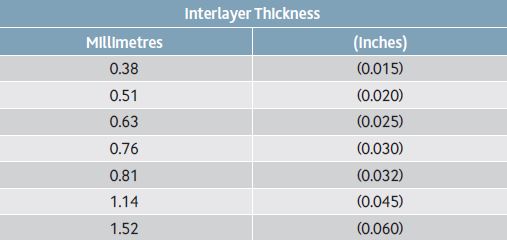History
In 1938, Monsanto began manufacturing PVB resin in a joint venture with Shawinigan Resins of Canada, which resulted in the production of Saflex brand interlayer at its adjoining plant in Springfield, Massachusetts. These early interlayers offered vastly improved processing and windscreen performance compared to the previously used cellulose acetate and quickly displaced it in this application. By the early 1950s, architectural use of laminated glass began to increase and coloured interlayer products were introduced for this application. Monsanto developed a process to put a gradient color band on the automotive interlayer and began offering it commercially in 1951. In the early 1960s, Monsanto expanded its production facilities to Trenton, Michigan and Ghent, Belgium and introduced the first “HPR” (High Penetration Resistant) interlayer in 1965. This product approximately tripled the penetration resistance of windscreens and federal standards requiring laminated windscreens in the United States were enacted in 1967. In 1997, Monsanto’s chemical business was spun off to create Solutia, which merged with Eastman Chemical in 2012. Eastman Chemical remains fully committed to maintaining the Saflex leadership position and serving the laminated glass market for years to come. Eastman Chemical is recognized as a world leader in PVB interlayer and has continued to expand production facilities worldwide and meet new needs of the laminating industry with products offering superior processing, laminate performance and durability.
What is Saflex PVB interlayer?
Saflex is a plasticised polyvinyl butyral (PVB) film that bonds with glass under heat and pressure to form laminated safety glass. The Saflex interlayer sandwiched between the layers of glass is responsible for the enhanced performance properties of laminated glass. It is sold as refrigerated or interleaved rolls and is manufactured in a variety of formulations, colors, and thicknesses for use in laminated architectural, transportation and specialty glazings.
For information regarding specific product availability, contact a local Saflex representative.
Composition
Saflex® brand PVB is a film consisting of approximately 75% PVB resin and 25% plasticiser. Architectural grades of Saflex are plasticised with Santicizer® S2075 plasticiser, or trietylene glycol di-2-ethyl hexanoate. Specialty grades of Saflex have different compositions. Small quantities of other proprietary materials are added for adhesion control, ultra-violet screening agents and color.
Thicknesses

UV, Visible and NIR Light Properties
Saflex® interlayers contain ultra violet (UV) stabilisers that significantly reduce the amount of ultraviolet light transmitted through the laminate.
If data for different glass thicknesses is required, please contact our Eastman Technical Service Representative.




